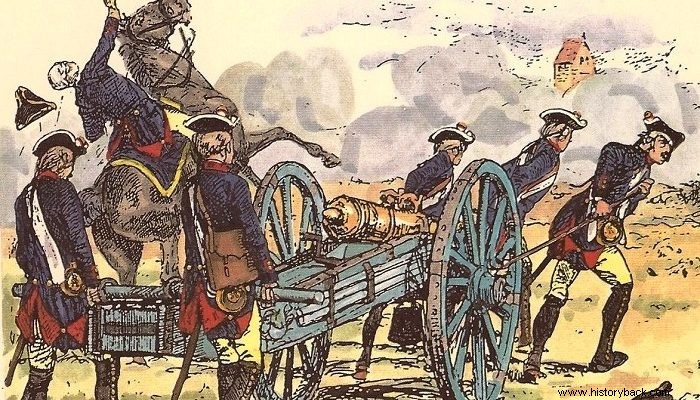
Artillery in that period was in all, except the Austrian, armies the "poor" relative of the proud weapons of infantry and cavalry. In this were mainly the scions of bourgeois families, leaving the nobles to staff the other arms. Even the inclusion of men in the artillery was problematic, since those who were left over from the other weapons literally joined it.
The gunners, officers and men, were treated as second-class soldiers, as "artisans", manual laborers, the necessary evil of the army. This treatment had as a natural consequence the low quality of the Prussian artillery and the low manning rate of its units, especially in respectable officers. The relatively modest performance of the Prussian artillery was also due to the difficulty of using the guns with which it was armed.
Prussian guns were generally heavier and had a shorter range than their Austrian counterparts. Many were poorly constructed, as a result of which it was not possible to aim them easily. Frederick himself, during an exercise, berated the servants of a cannon for their failure to hit the target. The king aimed the cannon himself and, perhaps by luck, hit the target. Angry, the shooters challenged him to repeat the shot.
The king's second shot, indeed, was tragically misplaced. This historical anecdote perfectly illustrates the ineffectiveness of cannons. Another negative factor was the insufficient armament of the gunners. The men were armed only with a short sword. Thus, by definition, they had little chance of facing an enemy raid against their positions. Despite the disadvantages, however, the Prussian gunners fought satisfactorily. In fact, they particularly distinguished themselves in the battles of Rosbach, Luten and Kunersdorf.
When Frederick ascended the throne in 1740, the artillery arm had a single squadron of field artillery, of six artillery pieces and four fortress artillery pieces. In 1741, a second squadron was formed, which consisted of five common artillery pieces and one "Bombardier" artillery piece, siege artillery. This artillery was equipped exclusively with howitzers and howitzers.
In 1742, another regiment of fortress artillery was formed. In 1744, the two squadrons were united under the 1st Field Artillery Regiment, commanded by the chosen father of Prussian artillery, the former Austrian Army officer, von Schmittau. strong> With the outbreak of the Seven Years' War, a third squadron was formed. In 1762, a second artillery regiment was formed, also of three divisions.
In the latter stages of the Seven Years' War Frederick tried to make up for his infantry deficiencies with heavy concentrations of artillery. That is why he gave importance to the reconstruction and strengthening and re-equipment, with new guns, of the artillery. By 1772, four artillery regiments had been formed, each with two squadrons.
Each artillery had a strength of 300 men and 8-12 guns. Main types of guns in use were 24 and 12-pounder heavy guns and 8-inch field howitzers, 12-pounder medium guns and 10-pounder guns, 6-pounder medium-light guns and 7-inch howitzers and the light guns of 3 or 6 pounders.
The latter were given to the infantry battalions for their direct support (one or two guns per battalion). These guns (battalion guns) were served by an artillery gunner and loader, assigned for this purpose to the infantry unit, and by infantry men.
The Prussian Army was also a pioneer in the formation of mounted artillery units. Horse artillery differed from common position artillery in that the gunners moved on horseback.
In this way they were able to follow even the cavalry and support it with their fire, or quickly occupy key points of the front and fire from there against the enemy. The first mounted artillery was raised in April 1759. It had six 6-pounder guns and had a strength of 45 men.
The unit was disbanded at the disastrous Battle of Kunersdorf. However, it was reorganized and at the same time a second artillery was formed. Since then the development of mounted artillery has been rapid. By 1773, the year of the outbreak of the War of the Bavarian Succession, a mounted artillery squadron of six artillery pieces had been formed, with nine guns per artillery piece.
